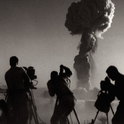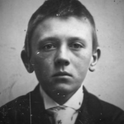Sofia Helin and Kim Bodnia in The Bridge, the latest and perhaps the most violent of Scandinavia’s crime dramas
A recent New Yorker cartoon nicely illustrates the case. A publisher and her author, both plainly American, sit in the publisher’s office, at the publisher’s desk, with the manuscript of the author’s latest novel between them. The publisher is enthusing over the work, declaring it a clever, well-plotted and fast-paced thriller—“only,” she says, “now can you make it Scandinavian?”
Nordic noir began, they say, with the ten books that the writing team of Maj Sjöwall and Per Wahlöö published, at the rate of one a year, over the decade between 1965 and 1975. These two left-wing authors were determined to show the falsity of the Swedish dream, which according to them allowed their complacently slumbering country to ignore the poverty, underprivilege and heartsickness endemic among its broad underclass. Their protagonist, the dour and sometimes anguished detective Martin Beck, is the first in a long line of Scandinavian police heroes, notably Henning Mankell’s Kurt Wallander, but he is also a forerunner of Smilla Jasperson, the alienated heroine of Peter Høeg’s 1992 novel Miss Smilla’s Feeling for Snow— published by that genius among publishers, Christopher MacLehose, the godfather, if not more, of Scandinavian crime fiction in English—and Mikael Blomkvist, the investigative journalist who is the foil to the feral Lisbeth Salander in The Girl with the Dragon Tattoo. Indeed, Beck may be the grandfather of the dragon-girl herself.
The difference between the Sjöwall and Wahlöö series, published in what already seems a vanished age, and books by Mankell, Stieg Larsson and Jo Nesbø, as well as the Scandinavian television series The Killing and The Bridge, is that there is at the heart of the more recent works a deep crevasse of angst, of existential helplessness and sorrow, which the two pioneering Marxist writers, despite their sense of general social alienation, would never have allowed themselves to stumble into. Sjöwall and Wahlöö were out to change society; their successors gaze upon their world—our world—and despair.
Given the bleakness in which it revels, how are we to account for the extraordinary commercial and even critical success of the new Scandinavian noir? The first thing to say in answer is that it is not really noir, not in the generally accepted sense of that much overused term. Noir is essentially American, and of a former time. Hammett, Chandler, James M Cain, and the makers of all those Hollywood B-movies of the pre-war years, they were the masters of noir, for noir needed above all cheapness, seediness, the disreputable, the hard graft. For Scandinavian crime writing we would need a new term, a word coined from the shine of snow, the glint of ice, the soft gleam along a well-turned wooden chair-arm.
The attraction of all crime and detective stories is that they offer the fantasy of a reordering of a disordered world. Nothing shatters the brittle surface of civilisation more thoroughly than murder. In the classic Agatha Christie whodunnit, for instance, a seemingly placid miniature world-order is temporarily but violently overturned the moment the maid stumbles upon that inevitable body in the library. As the investigation gets under way, and Hercule Poirot’s little grey cells begin to seethe, stiff upper lips fall a-trembling and all kinds of carefully hidden secrets leak out. It is the master detective’s task not so much to find the murderer—“Who Cares Who Killed Roger Ackroyd?” Edmund Wilson testily demanded—as to force the genie of chaos back into its lamp.
In the heyday of British detective fiction, from the 1920s through the 1950s, it is remarkable how many writers in the genre were female. And not just female, but females of a very particular kind. Consider them, all those ladies in flowered frocks harbouring murder in their hearts: Margery Allingham, Josephine Tey, Dorothy L Sayers, Georgette Heyer, Ngaio Marsh—a New Zealander, yes, but only by accident of birth—and, of course, the doyenne, Miss Christie herself, by a nice coincidence the bearer of the name of a notorious, real-life murderer. While other English roses got married and kept the home fires burning, the job of the ladies of that other regiment was to assure their readers that the world is amenable to the ordering spirit. Murder will out, will it? Well, by jingo, M. Poirot, Miss Marple or Lord Peter Wimsey will soon tidy up that little mess.
It is arguable, or at any rate we shall argue it here, that Scandinavia, the Scandinavia of the popular imagination, that is, has much in common with the England of the inter-war years. Those countries up there may be cold and have brain-numbingly long nights, but to our mind they are ordered, liberal, comfortably appointed—think of all those padded parkas, all those dependable Volvos—and reassuringly dull. The last thing to be expected of Sweden, Norway, Denmark, is wanton murder. But that is just what Mankell, Larsson, Nesbø, Iceland’s Arnaldur Indridason, as well as the writers and producers of The Killing and The Bridge, have to offer us: murder by the book- and screenful, and murder most foul, at that.
Ask a Swede when Sweden’s conception of itself changed, when its grasp on the principles of an ordered, civilised society slackened and grew infirm, and he or she will immediately cite the date 28th February 1986, when the prime minister, Olof Palme, the very model of a modern Swedish leader, was assassinated just before midnight in a broad street in central Stockholm as he and his wife strolled home from the cinema. Although one Christer Pettersson, a small-time criminal, was arrested, tried and found guilty of shooting Palme, the conviction was later overturned, and the murder, and the motive for it, remain a mystery. Was he, a famous liberal, gunned down by a neo-fascist agent? Or, since he was in the habit of castigating the policies of both East and West in the Cold War, did the KGB or the CIA send in a hitman to silence a fearless and insistent critic? Conspiracy theories abound—one such suggests that Palme was a victim of the South African government’s campaign against international critics of apartheid.
Echoes of the Palme case reverberate throughout contemporary Scandinavian crime fiction and television thrillers. An unsolved murder is a great disturber of the public’s peace of mind, especially the murder of such a prominent and generally well-regarded figure as Olof Palme. Surely this outrage, and the subsequent inability of the police to bring its perpetrator to justice, was an indication of something definitely rotten in the state of Sweden. This is not necessarily so, of course; Palme’s death may have been the result of a personal grudge, it may have been a random act by a deranged loner; but the thought that such a momentous atrocity had no reason to it is somehow even more dismaying, more an affront to our notions of what the polity can reasonably expect for and from itself, than the belief that it was carried out as part of a conspiracy and at the behest of some powerful secret agency. Better the devil we might guess at than no devil at all.
At this point it probably behoves us to clamber down from the giddy heights of psychological speculation and return to the mundane ground of everyday entertainment. Murder, even real-life murder, is great fun, at a safe remove. George Orwell caught our secret predilection wonderfully well in the famous opening to his essay “Decline of the English Murder”:
It is Sunday afternoon, preferably before the war. The wife is already asleep in the armchair, and the children have been sent out for a nice long walk. You put your feet up on the sofa, settle your spectacles on your nose, and open the News of the World. Roast beef and Yorkshire, or roast pork and apple sauce, followed up by suet pudding and driven home, as it were, by a cup of mahogany-brown tea, have put you in just the right mood. Your pipe is drawing sweetly, the sofa cushions are soft underneath you, the fire is well alight, the air is warm and stagnant. In these blissful circumstances, what is it that you want to read about?
Naturally, about a murder.
Orwell goes on to mention Jack the Ripper, Dr Crippen, Frederick Seddon, whose crimes, dreadful though they were, seem to pale to mere hobbyist pursuits when compared to the doings of latter-day monsters such as Dennis Nilsen or Fred and Rosemary West. Not to be outdone by villains—indeed, set on outdoing them—crime writers nowadays ratchet up the violenceometer to an ever higher pitch. There has been hardly a crime novel or television thriller in the past ten years or so that does not open with the discovery of the body of a young woman who has been sexually abused, beaten and murdered. It is astonishing, surely, that more women and women’s groups have not come out in protest at this by now firmly established but appalling convention. Where will it end? Even the most fiendishly minded writer can only push the envelope so far, and is bound eventually to reach a horror threshold—or is there a stratosphere, a whole outer space, where as yet untold-of enormities await the telling?
A while ago in the New Yorker that fine critic Joan Acocella wrote a perceptive article on the Stieg Larsson phenomenon. Her tone was one of mild wonder that at times became bafflement. How, she pleaded, could books so implausible, so clumsily plotted and poorly written—in short, such bad books—have become so stupendously popular? Well, first of all, despite the fact that they are everything and more than Ms Acocella says they are, The Girl with the Dragon Tattoo and its two successors are simply, compellingly, horribly readable. But that is the least of it. Consider what Larsson, however pure his intentions may have been, actually offers us: extreme brutality and sexual violence visited for the most part upon defenceless young women; a young woman protagonist who is herself brutal and violently sexual, an avenging angel de nos jours; a male lead—from the outset these books were bound for the cinema—who is unfailingly politically correct, a liberal, a feminist, a fearless avenger of public wrongs; and, not least, writing that seems to have been done with the blunt end of a burnt stick. All in all, the perfect formula for a worldwide bestseller.
The only Scandinavian crime writer who even begins to rival Larsson in terms of commercial success, Henning Mankell, is of a different order. His books are competently written, his heart is more or less in the right place, and he has a genuine social conscience. He is fortunate, too, in that his policeman-hero, Kurt Wallander, has been played in various television series by no fewer than three actors, all of them good, but none as good as the superb Krister Henriksson, who overcomes a consistent silliness of plotting to bring to the part a sense of the tragic that is frequently and deeply moving. Indeed, there is a true-life tragedy attached to the series in which Henriksson starred, in that the young actress who played his daughter Linda, Johanna Sällström, who had suffered for years from depression, took her own life in 2007. Henriksson, and Mankell, have spoken movingly of her talent and the sadness of her death.
The two television series, The Killing, written by Søren Sveistrup and made in Denmark, and The Bridge, a Danish-Swedish co-production, seem the epitome, and may be the culmination, of the Scandinavian boom in crime writing. They are extremely long—the first series of The Killing ran to 20 hour-long episodes—and have almost inextricably intricate plotlines. They are also markedly violent. The Killing’s leading lady, if one may be permitted such an antique term, the po-faced Sarah Lund, played by Sofie Gråbøl in an unflattering Faroese jumper that has become an unlikely but hot fashion topic, is a new kind of television heroine, tough and driven yet touchingly insecure. Gråbøl acts the part with conviction and subtlety—indeed, a large part of the success of the show is the quality of the cast. The supporting leads are marvellous, in particular Lars Mikkelsen as the would-be decent politician around whom the plot seems to revolve, and Ann Eleonora Jørgensen and Bjarne Henriksen as the stricken parents of the girl whose brutal murder sets the action going.
The Bridge, written by Hans Rosenfeldt, marks another stage in onscreen violence, opening with the discovery one night on the Øresund bridge connecting Copenhagen in Denmark with Malmö in Sweden of a body which later turns out to be the top half of the corpse of a prominent female Swedish politician joined to the bottom half of a Danish prostitute. The lead character here is a more extreme version of The Killing’s Sarah Lund. Saga Norén, a Swedish police officer, is portrayed by Sofia Helin as a kind of android that would not have been out of place in Blade Runner, while her opposite number, the Danish cop—and he is very much a cop rather than a policeman—Marin Rohde, played by Kim Bodnia, is a shambling but warmly sympathetic poor fellow who when the action opens has just undergone a vasectomy and is in pain both physical and psychological.
What marks these shows are the very high “production values,” as they are called in the trade: stylish design, smoothly inventive photography, fine acting in even the minor roles. The sense of place in both series is strong, which is not to say that the places themselves are strong. This is very much contemporary Scandinavia, anonymous and bland, as far from Bergman’s Wild Strawberries or Fanny and Alexander as could be. Yet like the Nordic crime novels that are their predecessors, what they offer essentially is that sense of cosiness identified in Orwell’s essay, and which is the secret attraction of all these fantasies of violence and mayhem.
In both The Killing and The Bridge, as in Stieg Larsson’s novels, we are shown, as if incidentally, a world in which no one wants for the rudiments of the good life. The houses are warm and comfortable, the cars are modest but solidly built, the politicians, though they may be as dodgy as politicians everywhere, do try to represent their constituents decently and to the best of their ability. This is, we understand, about the most that human beings can ask from life. Even the murders, hideous though they be, cannot entirely topple the pillars of society, and savage as they are and senseless as they seem, there is a rational, controlling mind behind them. And meanwhile the snow falls...
By now, after so many mock-murders and so much fake blood, you may feel in need of an antidote. There is one to hand. Michael Haneke may be an Austrian, but he has his eye on those Scandinavians, and in his film Funny Games he shows us a version of violence that is far more plausible, more likely, and not at all, not at all cosy. Watch it, and tremble.
A recent New Yorker cartoon nicely illustrates the case. A publisher and her author, both plainly American, sit in the publisher’s office, at the publisher’s desk, with the manuscript of the author’s latest novel between them. The publisher is enthusing over the work, declaring it a clever, well-plotted and fast-paced thriller—“only,” she says, “now can you make it Scandinavian?”
Nordic noir began, they say, with the ten books that the writing team of Maj Sjöwall and Per Wahlöö published, at the rate of one a year, over the decade between 1965 and 1975. These two left-wing authors were determined to show the falsity of the Swedish dream, which according to them allowed their complacently slumbering country to ignore the poverty, underprivilege and heartsickness endemic among its broad underclass. Their protagonist, the dour and sometimes anguished detective Martin Beck, is the first in a long line of Scandinavian police heroes, notably Henning Mankell’s Kurt Wallander, but he is also a forerunner of Smilla Jasperson, the alienated heroine of Peter Høeg’s 1992 novel Miss Smilla’s Feeling for Snow— published by that genius among publishers, Christopher MacLehose, the godfather, if not more, of Scandinavian crime fiction in English—and Mikael Blomkvist, the investigative journalist who is the foil to the feral Lisbeth Salander in The Girl with the Dragon Tattoo. Indeed, Beck may be the grandfather of the dragon-girl herself.
The difference between the Sjöwall and Wahlöö series, published in what already seems a vanished age, and books by Mankell, Stieg Larsson and Jo Nesbø, as well as the Scandinavian television series The Killing and The Bridge, is that there is at the heart of the more recent works a deep crevasse of angst, of existential helplessness and sorrow, which the two pioneering Marxist writers, despite their sense of general social alienation, would never have allowed themselves to stumble into. Sjöwall and Wahlöö were out to change society; their successors gaze upon their world—our world—and despair.
Given the bleakness in which it revels, how are we to account for the extraordinary commercial and even critical success of the new Scandinavian noir? The first thing to say in answer is that it is not really noir, not in the generally accepted sense of that much overused term. Noir is essentially American, and of a former time. Hammett, Chandler, James M Cain, and the makers of all those Hollywood B-movies of the pre-war years, they were the masters of noir, for noir needed above all cheapness, seediness, the disreputable, the hard graft. For Scandinavian crime writing we would need a new term, a word coined from the shine of snow, the glint of ice, the soft gleam along a well-turned wooden chair-arm.
The attraction of all crime and detective stories is that they offer the fantasy of a reordering of a disordered world. Nothing shatters the brittle surface of civilisation more thoroughly than murder. In the classic Agatha Christie whodunnit, for instance, a seemingly placid miniature world-order is temporarily but violently overturned the moment the maid stumbles upon that inevitable body in the library. As the investigation gets under way, and Hercule Poirot’s little grey cells begin to seethe, stiff upper lips fall a-trembling and all kinds of carefully hidden secrets leak out. It is the master detective’s task not so much to find the murderer—“Who Cares Who Killed Roger Ackroyd?” Edmund Wilson testily demanded—as to force the genie of chaos back into its lamp.
In the heyday of British detective fiction, from the 1920s through the 1950s, it is remarkable how many writers in the genre were female. And not just female, but females of a very particular kind. Consider them, all those ladies in flowered frocks harbouring murder in their hearts: Margery Allingham, Josephine Tey, Dorothy L Sayers, Georgette Heyer, Ngaio Marsh—a New Zealander, yes, but only by accident of birth—and, of course, the doyenne, Miss Christie herself, by a nice coincidence the bearer of the name of a notorious, real-life murderer. While other English roses got married and kept the home fires burning, the job of the ladies of that other regiment was to assure their readers that the world is amenable to the ordering spirit. Murder will out, will it? Well, by jingo, M. Poirot, Miss Marple or Lord Peter Wimsey will soon tidy up that little mess.
It is arguable, or at any rate we shall argue it here, that Scandinavia, the Scandinavia of the popular imagination, that is, has much in common with the England of the inter-war years. Those countries up there may be cold and have brain-numbingly long nights, but to our mind they are ordered, liberal, comfortably appointed—think of all those padded parkas, all those dependable Volvos—and reassuringly dull. The last thing to be expected of Sweden, Norway, Denmark, is wanton murder. But that is just what Mankell, Larsson, Nesbø, Iceland’s Arnaldur Indridason, as well as the writers and producers of The Killing and The Bridge, have to offer us: murder by the book- and screenful, and murder most foul, at that.
Ask a Swede when Sweden’s conception of itself changed, when its grasp on the principles of an ordered, civilised society slackened and grew infirm, and he or she will immediately cite the date 28th February 1986, when the prime minister, Olof Palme, the very model of a modern Swedish leader, was assassinated just before midnight in a broad street in central Stockholm as he and his wife strolled home from the cinema. Although one Christer Pettersson, a small-time criminal, was arrested, tried and found guilty of shooting Palme, the conviction was later overturned, and the murder, and the motive for it, remain a mystery. Was he, a famous liberal, gunned down by a neo-fascist agent? Or, since he was in the habit of castigating the policies of both East and West in the Cold War, did the KGB or the CIA send in a hitman to silence a fearless and insistent critic? Conspiracy theories abound—one such suggests that Palme was a victim of the South African government’s campaign against international critics of apartheid.
Echoes of the Palme case reverberate throughout contemporary Scandinavian crime fiction and television thrillers. An unsolved murder is a great disturber of the public’s peace of mind, especially the murder of such a prominent and generally well-regarded figure as Olof Palme. Surely this outrage, and the subsequent inability of the police to bring its perpetrator to justice, was an indication of something definitely rotten in the state of Sweden. This is not necessarily so, of course; Palme’s death may have been the result of a personal grudge, it may have been a random act by a deranged loner; but the thought that such a momentous atrocity had no reason to it is somehow even more dismaying, more an affront to our notions of what the polity can reasonably expect for and from itself, than the belief that it was carried out as part of a conspiracy and at the behest of some powerful secret agency. Better the devil we might guess at than no devil at all.
At this point it probably behoves us to clamber down from the giddy heights of psychological speculation and return to the mundane ground of everyday entertainment. Murder, even real-life murder, is great fun, at a safe remove. George Orwell caught our secret predilection wonderfully well in the famous opening to his essay “Decline of the English Murder”:
It is Sunday afternoon, preferably before the war. The wife is already asleep in the armchair, and the children have been sent out for a nice long walk. You put your feet up on the sofa, settle your spectacles on your nose, and open the News of the World. Roast beef and Yorkshire, or roast pork and apple sauce, followed up by suet pudding and driven home, as it were, by a cup of mahogany-brown tea, have put you in just the right mood. Your pipe is drawing sweetly, the sofa cushions are soft underneath you, the fire is well alight, the air is warm and stagnant. In these blissful circumstances, what is it that you want to read about?
Naturally, about a murder.
Orwell goes on to mention Jack the Ripper, Dr Crippen, Frederick Seddon, whose crimes, dreadful though they were, seem to pale to mere hobbyist pursuits when compared to the doings of latter-day monsters such as Dennis Nilsen or Fred and Rosemary West. Not to be outdone by villains—indeed, set on outdoing them—crime writers nowadays ratchet up the violenceometer to an ever higher pitch. There has been hardly a crime novel or television thriller in the past ten years or so that does not open with the discovery of the body of a young woman who has been sexually abused, beaten and murdered. It is astonishing, surely, that more women and women’s groups have not come out in protest at this by now firmly established but appalling convention. Where will it end? Even the most fiendishly minded writer can only push the envelope so far, and is bound eventually to reach a horror threshold—or is there a stratosphere, a whole outer space, where as yet untold-of enormities await the telling?
A while ago in the New Yorker that fine critic Joan Acocella wrote a perceptive article on the Stieg Larsson phenomenon. Her tone was one of mild wonder that at times became bafflement. How, she pleaded, could books so implausible, so clumsily plotted and poorly written—in short, such bad books—have become so stupendously popular? Well, first of all, despite the fact that they are everything and more than Ms Acocella says they are, The Girl with the Dragon Tattoo and its two successors are simply, compellingly, horribly readable. But that is the least of it. Consider what Larsson, however pure his intentions may have been, actually offers us: extreme brutality and sexual violence visited for the most part upon defenceless young women; a young woman protagonist who is herself brutal and violently sexual, an avenging angel de nos jours; a male lead—from the outset these books were bound for the cinema—who is unfailingly politically correct, a liberal, a feminist, a fearless avenger of public wrongs; and, not least, writing that seems to have been done with the blunt end of a burnt stick. All in all, the perfect formula for a worldwide bestseller.
The only Scandinavian crime writer who even begins to rival Larsson in terms of commercial success, Henning Mankell, is of a different order. His books are competently written, his heart is more or less in the right place, and he has a genuine social conscience. He is fortunate, too, in that his policeman-hero, Kurt Wallander, has been played in various television series by no fewer than three actors, all of them good, but none as good as the superb Krister Henriksson, who overcomes a consistent silliness of plotting to bring to the part a sense of the tragic that is frequently and deeply moving. Indeed, there is a true-life tragedy attached to the series in which Henriksson starred, in that the young actress who played his daughter Linda, Johanna Sällström, who had suffered for years from depression, took her own life in 2007. Henriksson, and Mankell, have spoken movingly of her talent and the sadness of her death.
The two television series, The Killing, written by Søren Sveistrup and made in Denmark, and The Bridge, a Danish-Swedish co-production, seem the epitome, and may be the culmination, of the Scandinavian boom in crime writing. They are extremely long—the first series of The Killing ran to 20 hour-long episodes—and have almost inextricably intricate plotlines. They are also markedly violent. The Killing’s leading lady, if one may be permitted such an antique term, the po-faced Sarah Lund, played by Sofie Gråbøl in an unflattering Faroese jumper that has become an unlikely but hot fashion topic, is a new kind of television heroine, tough and driven yet touchingly insecure. Gråbøl acts the part with conviction and subtlety—indeed, a large part of the success of the show is the quality of the cast. The supporting leads are marvellous, in particular Lars Mikkelsen as the would-be decent politician around whom the plot seems to revolve, and Ann Eleonora Jørgensen and Bjarne Henriksen as the stricken parents of the girl whose brutal murder sets the action going.
The Bridge, written by Hans Rosenfeldt, marks another stage in onscreen violence, opening with the discovery one night on the Øresund bridge connecting Copenhagen in Denmark with Malmö in Sweden of a body which later turns out to be the top half of the corpse of a prominent female Swedish politician joined to the bottom half of a Danish prostitute. The lead character here is a more extreme version of The Killing’s Sarah Lund. Saga Norén, a Swedish police officer, is portrayed by Sofia Helin as a kind of android that would not have been out of place in Blade Runner, while her opposite number, the Danish cop—and he is very much a cop rather than a policeman—Marin Rohde, played by Kim Bodnia, is a shambling but warmly sympathetic poor fellow who when the action opens has just undergone a vasectomy and is in pain both physical and psychological.
What marks these shows are the very high “production values,” as they are called in the trade: stylish design, smoothly inventive photography, fine acting in even the minor roles. The sense of place in both series is strong, which is not to say that the places themselves are strong. This is very much contemporary Scandinavia, anonymous and bland, as far from Bergman’s Wild Strawberries or Fanny and Alexander as could be. Yet like the Nordic crime novels that are their predecessors, what they offer essentially is that sense of cosiness identified in Orwell’s essay, and which is the secret attraction of all these fantasies of violence and mayhem.
In both The Killing and The Bridge, as in Stieg Larsson’s novels, we are shown, as if incidentally, a world in which no one wants for the rudiments of the good life. The houses are warm and comfortable, the cars are modest but solidly built, the politicians, though they may be as dodgy as politicians everywhere, do try to represent their constituents decently and to the best of their ability. This is, we understand, about the most that human beings can ask from life. Even the murders, hideous though they be, cannot entirely topple the pillars of society, and savage as they are and senseless as they seem, there is a rational, controlling mind behind them. And meanwhile the snow falls...
By now, after so many mock-murders and so much fake blood, you may feel in need of an antidote. There is one to hand. Michael Haneke may be an Austrian, but he has his eye on those Scandinavians, and in his film Funny Games he shows us a version of violence that is far more plausible, more likely, and not at all, not at all cosy. Watch it, and tremble.












